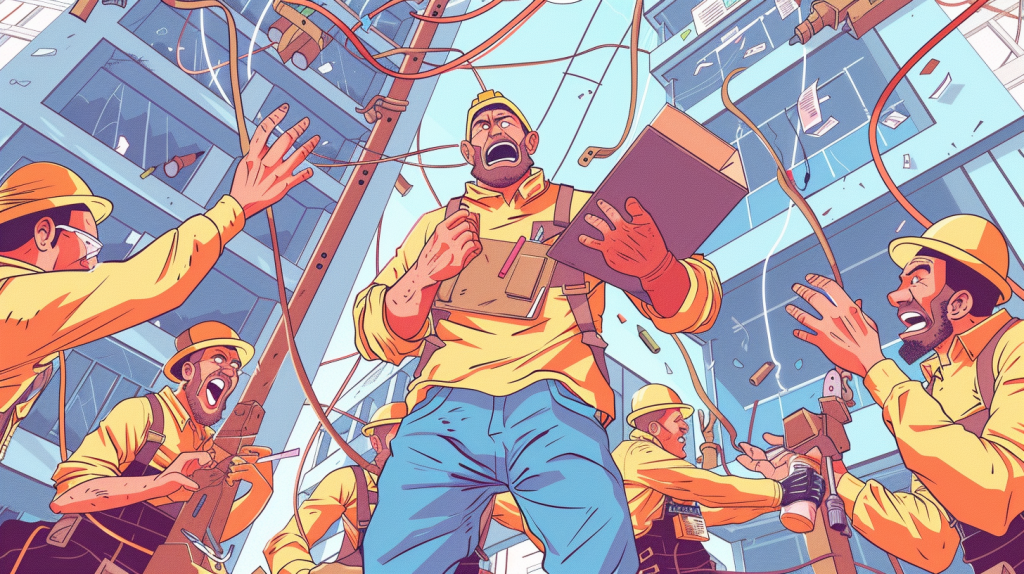How Predictive Analytics Help Superintendents Prevent Delays and Stay on Track
Table of Contents:

Why Delays Happen in Construction and What Predictive Analytics Can Do About It
Construction delays can feel inevitable. Weather shifts, material shortages, subcontractor miscommunications, and unexpected change orders all chip away at even the best-laid schedules. For superintendents tasked with managing day-to-day field progress, it often feels like playing catch-up instead of staying ahead. Predictive analytics is changing that dynamic by helping leaders anticipate risks early and make smarter decisions before delays occur.
Rather than reacting after something has gone wrong, predictive tools analyze patterns in data like task duration, labor productivity, or delivery schedules to highlight areas of concern. These tools can flag where a project is falling behind, when a resource shortage may happen, or which trade is consistently missing targets. This gives superintendents time to reassign crews, order materials earlier, or adjust workflows before small issues snowball into major hold-ups.
The power of predictive analytics lies in turning data into foresight. By surfacing early warnings from the field, superintendents gain the insight they need to keep the job moving forward, day after day. It’s not about replacing experience, it’s about giving seasoned leaders the tools to act with more clarity and less guesswork.
Top Features
- Real-time performance tracking with trend forecasting
- Schedule risk modeling based on task history and productivity
- Material delivery and labor allocation predictions
- Custom alerts for early warning signs and bottlenecks
Top Benefits
- Reduces schedule slips by identifying problems early
- Helps superintendents make proactive, data-backed decisions
- Increases team confidence and alignment with project goals
- Minimizes rework and rushed last-minute coordination
Best Practices
- Monitor dashboards daily for trends across key tasks
- Use predictive tools to prioritize high-risk activities
- Share forecasts with the office and subs to realign expectations
- Adjust labor and delivery plans before issues escalate
Predictive analytics puts the superintendent back in control—not by guessing what’s coming, but by seeing it clearly before it hits.

How Superintendents Use Predictive Data to Stay Ahead of Scheduling Risks
Staying on schedule takes more than watching the calendar—it requires understanding where time is being lost before it causes downstream disruption. Predictive analytics helps superintendents spot these problem areas by analyzing data points from labor logs, equipment usage, task durations, and crew productivity. Instead of just recording what happened, these tools show what is likely to happen next.
If a framing crew is consistently finishing tasks a day behind, predictive models can project future delays across drywall, electrical, and inspections. If a delivery was late last week and a similar shipment is coming from the same supplier, the tool can flag that as a likely risk. These early signals give superintendents room to act—by calling in an extra crew, resequencing tasks, or notifying the office of potential changes.
The result is better control over time. Superintendents can work with trades to adjust plans on the fly while keeping clients informed with realistic expectations. Predictive data turns scheduling into a collaborative, flexible process instead of a rigid plan that gets thrown off by the first bump in the road.
Top Features
- Historical task duration tracking by trade and activity
- Delay forecasts tied to material deliveries or crew productivity
- Visual schedule maps showing areas of risk
- Alerts for critical path disruptions or weather impacts
Top Benefits
- Helps prevent cascading delays across dependent tasks
- Gives superintendents tools to re-sequence jobs effectively
- Strengthens coordination with trades and suppliers
- Reduces the stress of “putting out fires” last minute
Best Practices
- Review predicted delays weekly with your project team
- Use risk maps to focus attention on vulnerable areas
- Include predictive insights in your morning crew huddles
- Coordinate rescheduling early to avoid field conflicts
With predictive tools guiding their daily planning, superintendents can lead with foresight and precision—keeping progress steady even when surprises pop up.
What Types of Data Are Most Useful for Predicting Construction Delays?
Not all data is equally useful when it comes to forecasting delays. The most effective predictive tools focus on high-impact categories—like labor performance, task duration, material delivery timing, and equipment availability. These areas provide clear signals that, when tracked over time, can reveal where schedules are likely to slip.
Labor data is a key source. If a crew has fallen behind on similar projects in the past, or if productivity is trending down, it’s a sign that timelines need adjustment. Task duration trends are also important. By comparing current task progress to past benchmarks, predictive models can calculate expected finish dates with greater accuracy.
Material delivery tracking helps identify supply chain delays before they affect work. For example, if a supplier’s average delivery time has stretched in recent months, the tool may warn that a scheduled drop may arrive late. Combined with real-time weather feeds, equipment usage stats, and even inspection history, these data points give a full picture of what’s happening and what could derail progress next.
Top Features
- Integrated labor tracking tied to crew productivity rates
- Real-time material tracking linked to supplier trends
- Task-based analytics comparing actual vs planned durations
- Custom alerts based on project benchmarks and baselines
Top Benefits
- Makes forecasting more accurate by focusing on proven signals
- Empowers superintendents with actionable, job-specific insights
- Helps teams avoid last-minute surprises from labor or supply gaps
- Increases trust and transparency in project reporting
Best Practices
- Log labor and material updates daily to keep forecasts current
- Use past project data to fine-tune predictive thresholds
- Focus on tracking key path and long-lead activities
- Share predicted risks in weekly meetings to drive collaboration
By focusing on the right data, predictive analytics becomes more than a dashboard, it becomes a planning partner that helps superintendents steer their projects toward success.
Related Articles:
Best Guide to Construction Management Software
The Best Guide to Delivery Management Systems (DMS) for Commercial Construction

How Predictive Analytics Supports Smarter Resource Allocation
Managing resources on a construction site is like solving a puzzle in real time. Crews, equipment, and materials need to be in the right place, at the right time, and in the right quantity. Predictive analytics helps superintendents manage this balancing act more effectively by using historical data and real-time inputs to guide resource planning decisions before shortages or conflicts arise.
Instead of reacting to late material deliveries or misaligned crew schedules, superintendents can use predictive tools to spot where resources may run thin in the near future. If a task is trending behind schedule, the system may recommend adjusting crew size or reordering equipment to stay on pace. If weather is forecasted to delay concrete pours, it might flag the need to shift material deliveries or reprioritize tasks.
This proactive approach reduces idle time and overbooking while increasing productivity. Predictive analytics takes the guesswork out of resource planning and gives field leaders the visibility to move things around intelligently. That means fewer surprises, less waste, and smoother progress on the jobsite.
Top Features
- Crew productivity tracking tied to task duration models
- Equipment usage trends and downtime prediction
- Material lead time forecasts based on supplier performance
- Resource availability calendars aligned with schedule needs
Top Benefits
- Minimizes idle labor and unnecessary equipment rental
- Improves forecasting of material and delivery timing
- Helps superintendents prioritize where to deploy limited resources
- Supports more consistent progress across trades
Best Practices
- Track resource usage daily to feed real-time predictions
- Use forecasts to adjust crew sizes or shift delivery windows
- Review resource conflicts during weekly planning meetings
- Reroute equipment based on site demands and task priority
With predictive analytics guiding resource use, superintendents gain better control over the flow of labor, materials, and machinery—leading to fewer headaches and more reliable progress.
How Predictive Tools Improve Decision Making on the Jobsite
Field decisions often have to be made fast. Whether it’s responding to a delay, reassigning a crew, or adjusting the work sequence, superintendents don’t have the luxury of long analysis. Predictive analytics enhances decision-making by surfacing key data points and insights that make choices clearer, quicker, and more confident.
These tools don’t just dump data—they highlight what matters. A dashboard might show that a drywall task is trending two days behind and suggest rescheduling finish work. Another tool might show that weather could affect roofing in the next 48 hours, prompting a shift in trade priorities. These alerts give superintendents a real-time window into risks and opportunities.
The result is faster, smarter action. Decisions are based on data, not just gut instinct. This reduces the chance of rework, keeps projects aligned with budgets, and builds credibility with clients and stakeholders who want transparency and precision.
Top Features
- Customizable dashboards for task, crew, and material status
- Scenario modeling to test different scheduling strategies
- Delay probability scores with risk-based recommendations
- Visual alerts for urgent jobsite decisions
Top Benefits
- Improves confidence in time-sensitive field decisions
- Reduces reliance on reactive fixes and costly workarounds
- Aligns day-to-day actions with big-picture project goals
- Strengthens communication with office teams and ownership
Best Practices
- Use dashboard alerts to trigger immediate decision reviews
- Involve the team in reviewing recommendations during site walks
- Simulate “what if” scenarios before making major schedule shifts
- Document predictive insights in daily reports for visibility
By supporting better decision-making in real time, predictive tools help superintendents lead with focus and stay ahead of challenges before they turn into delays.
How StruxHub Helps Superintendents Leverage Predictive Insights
StruxHub supports superintendents using predictive analytics by organizing the data and documentation that feed these tools in the first place. While StruxHub doesn’t build predictive engines itself, the platform is built to work alongside them—providing the structure and visibility that helps field leaders act on insights effectively.
With StruxHub, superintendents can track daily task progress, log material delays, upload photos, and manage RFIs—all of which help create a clear data trail for predictive systems to analyze. Reports and field updates are linked directly to schedules and crews, making it easier to spot where things are trending off track.
The platform also supports collaboration. When predictive tools flag a risk, StruxHub allows users to assign tasks, notify subs, and adjust timelines—all in one place. This turns insights into action quickly without juggling apps or spreadsheets. Office teams can review field progress, ask questions, and plan adjustments in real time, closing the communication gap that often slows down decision-making.
Whether you’re using AI tools or simply looking to improve field visibility, StruxHub gives your team the centralized workspace to document, share, and act on project risks before they cause delays. It’s a smarter way to build—with the right information always at your fingertips.

StruxHub
Experience the power of StruxHub today and witness firsthand how it can revolutionize your construction operations.
FAQ
What is predictive analytics and how does it apply to construction?
Predictive analytics uses data patterns and machine learning to forecast what is likely to happen next. In construction, it means analyzing past project performance, real-time jobsite data, and external variables like weather to help superintendents and project managers make smarter decisions before delays or issues occur.
Instead of relying solely on gut feeling or past experience, predictive tools give field teams early warnings about risks. For example, if a certain trade consistently finishes a day late across similar projects, the software might flag that the same risk exists in your current schedule. If weather patterns indicate rain later in the week, the system might suggest rescheduling outdoor tasks ahead of time.
These insights help superintendents adjust crew schedules, materials delivery, and inspection timing proactively rather than reactively. The data can also reveal underperforming areas of the jobsite, giving superintendents the opportunity to coach crews or reallocate resources.
The benefit isn’t just speed—it’s precision. Predictive analytics provides a clearer picture of jobsite trends and turns historical lessons into real-time guidance. It allows construction leaders to steer projects more confidently, reduce downtime, and communicate more effectively with clients and stakeholders.
How can predictive analytics help avoid costly schedule delays?
Predictive analytics helps avoid schedule delays by identifying risks before they become problems. It reviews current field data—such as task completion rates, crew performance, material delivery status, and weather forecasts—and compares it to historical benchmarks and trends from similar projects. When it detects early signs of a delay, it triggers alerts so superintendents can act fast.
For example, if framing is taking longer than planned and will impact electrical and drywall, predictive tools highlight the downstream impact. Superintendents can then bring in extra labor, resequence trades, or extend working hours to keep the overall schedule intact.
This proactive approach is much more effective than reacting after a delay has already caused rework or missed milestones. Superintendents can coordinate with subs earlier, adjust resource allocation, or escalate concerns to the office with solid data to back up their decisions.
Even better, predictive insights often improve communication with clients and project owners. When changes are forecasted in advance, expectations can be managed clearly and transparently, avoiding last-minute surprises or disputes.
In short, predictive analytics gives construction leaders the advantage of time. By seeing problems before they escalate, superintendents can keep projects running smoothly and avoid costly interruptions that derail momentum.

StruxHub
Discover how StruxHub can revolutionize your construction management. Contact us today!
What kinds of construction data are most important for predictive analytics?
The most important data for predictive analytics in construction includes task duration, labor performance, material delivery timelines, equipment usage, weather conditions, and subcontractor history. These categories tend to have the biggest influence on project timelines and help forecast future risks with accuracy.
Labor data is key. How long a crew takes to complete a task, how often absences or slowdowns occur, and how that compares to previous benchmarks can reveal whether a job is trending behind. Similarly, task tracking helps flag which phases are moving ahead or lagging, giving superintendents a chance to shift resources.
Material delivery data is equally important. Predictive tools can monitor supplier lead times and identify delivery patterns that suggest potential delays. When tied to scheduling software, these insights help adjust timelines before the field is left waiting for materials.
Weather and equipment data also play a role. Rain, heat, and wind can impact productivity, especially for concrete or roofing tasks. Equipment downtime or poor availability adds another layer of complexity that predictive tools can highlight.
When all of this data is centralized and updated daily, predictive systems become more accurate. That’s why platforms like StruxHub are helpful—they keep jobsite records organized and ready to fuel smarter, faster analysis.
Is predictive analytics only useful for large construction firms?
Not at all. While predictive analytics was once considered a tool for enterprise-level construction firms, it’s now more accessible and valuable to small and mid-sized teams as well. Thanks to cloud-based software, mobile-friendly apps, and affordable integrations, superintendents on any size jobsite can benefit from insights that help prevent delays and keep the project on track.
Even a small contractor working on multiple projects can use predictive tools to identify recurring problems or refine schedules based on real jobsite performance. The key is choosing tools that are easy to use and don’t require a full-time analyst to operate. Many of today’s platforms handle the data modeling automatically and provide clear visual alerts and recommendations that field teams can act on without special training.
Smaller firms also benefit because delays hit harder when fewer resources are available to absorb them. Predictive analytics allows leaner teams to stay proactive and competitive—delivering jobs on time, improving profitability, and building trust with clients.
Whether you’re managing a commercial build, a tenant improvement project, or a specialty trade crew, predictive analytics can help you lead with foresight and confidence.
How does StruxHub support superintendents using predictive tools?
StruxHub supports predictive tools by giving superintendents a clean, structured environment for capturing, organizing, and acting on jobsite data. While StruxHub isn’t a predictive engine itself, it plays a crucial role in feeding the information these tools rely on—such as daily task updates, field notes, material status, and subcontractor activity.
Superintendents can use StruxHub to log progress, upload photos, assign tasks, and manage RFIs, all in one place. This creates a clear, organized data set that predictive systems can analyze more accurately. StruxHub also helps field teams stay aligned by giving them one place to review dashboards, check status, and coordinate around flagged risks.
When predictive tools identify a scheduling issue or resource conflict, StruxHub makes it easy to adjust the plan. Tasks can be reassigned, due dates updated, and notifications sent without bouncing between apps or spreadsheets. That keeps communication tight and decisions fast.
For project managers and office staff, StruxHub provides visibility into the field. Predictive alerts and field data are all accessible from a shared dashboard, helping the entire team respond together. It’s a streamlined way to turn insight into action—and keep every stakeholder informed.



